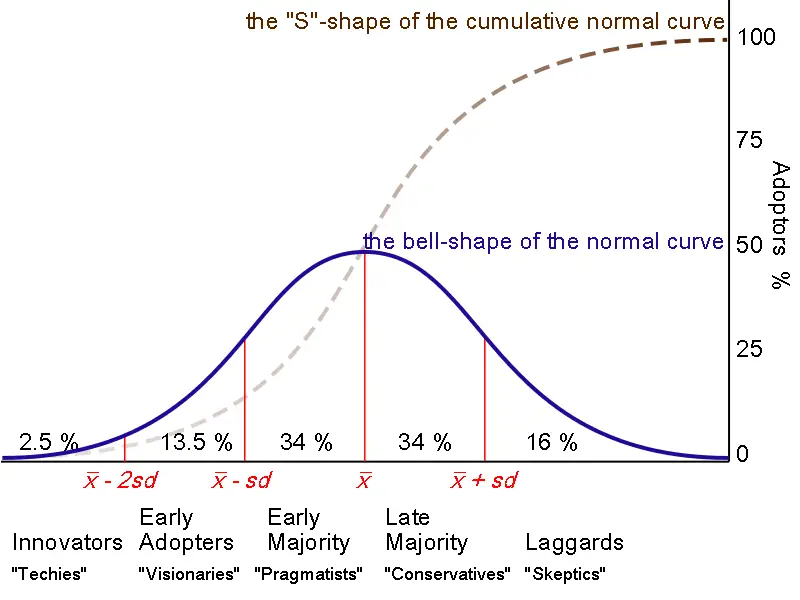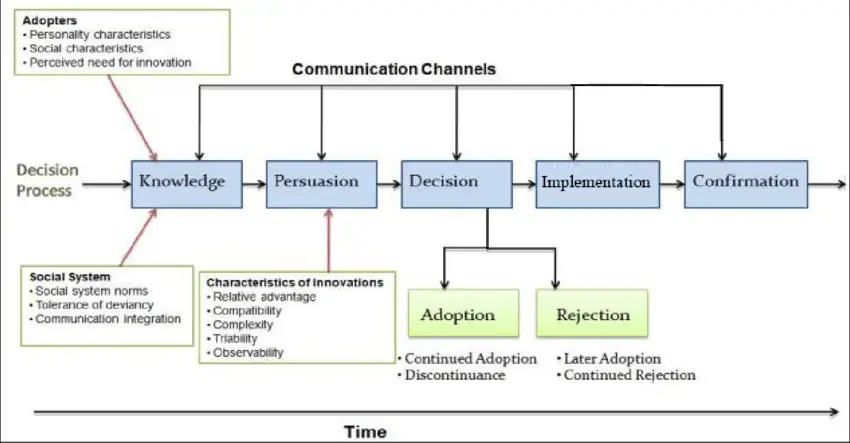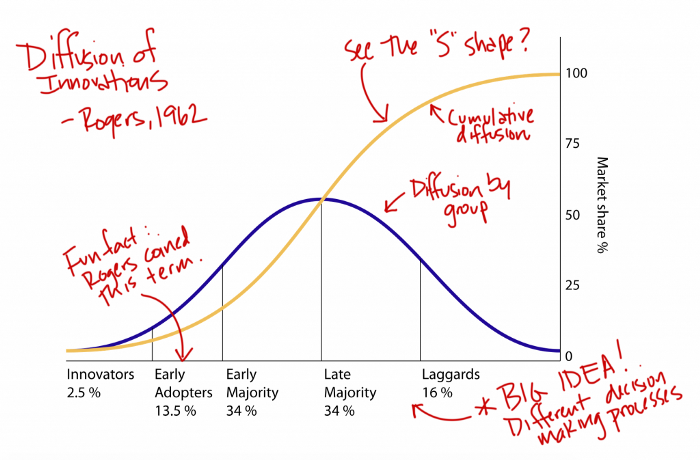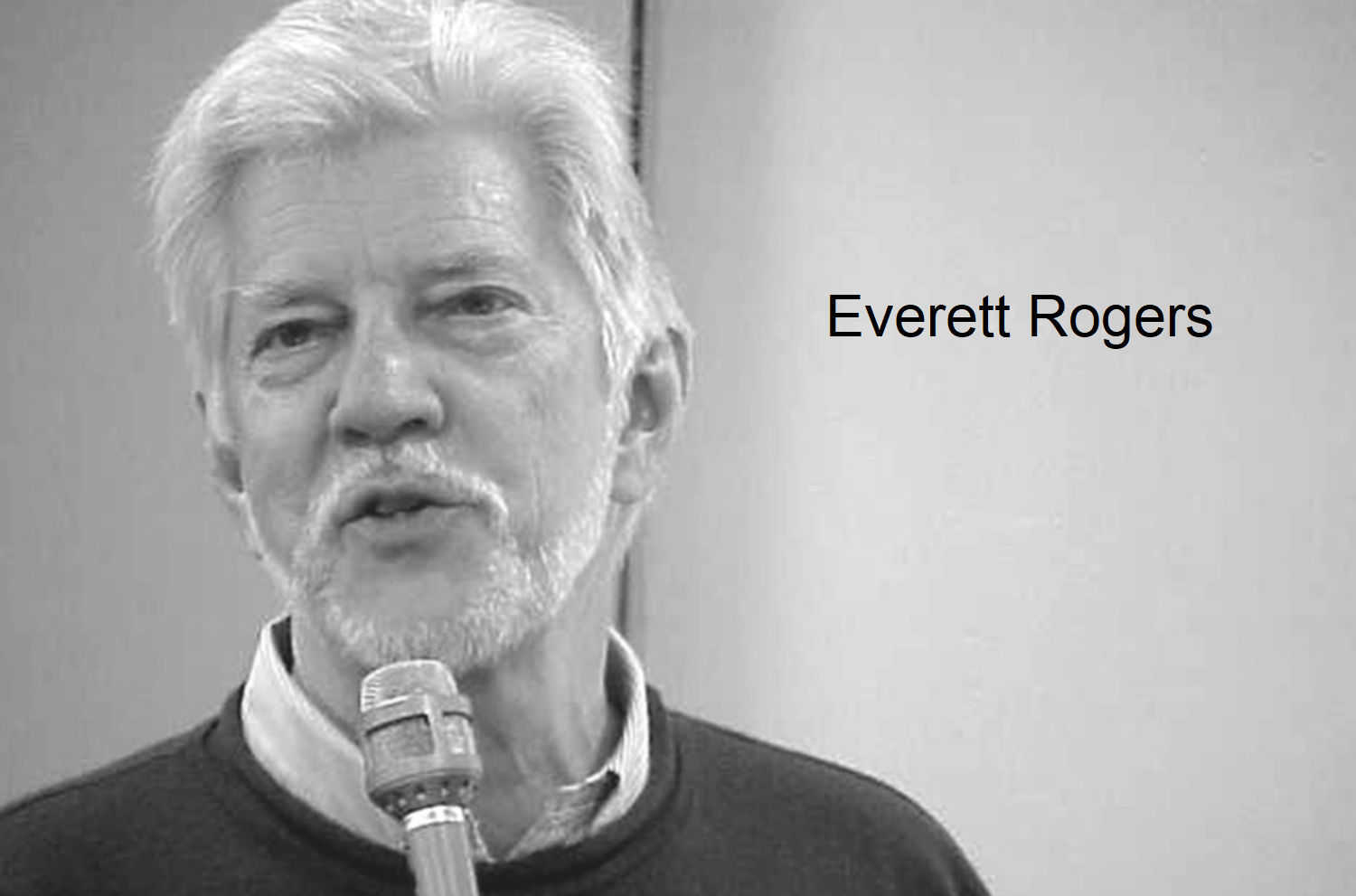Everett Rogers Diffusion of Innovation Theory
What is the Diffusion of Innovation Theory?
The theory of diffusion of innovations is defined as the overall spread of innovation and the process by which that innovation is communicated through certain channels again over time among members of a social system.
Innovation is defined as the idea that practice the object that is perceived as new by an individual or other unit of adoption.
History of Everett Rogers Diffusion of Innovation Theory
Diffusion of innovation theory is one of the oldest social theories out there and was developed in 1962 by Everett M. Rogers. The study’s purpose was to determine how an idea or an innovation gains momentum and spread through a population over a period of time. In the end, the result is the goal of the adoption of that idea or that innovation.
The theory was developed more than 50 years ago, and it’s called the diffusion of innovation theory. Everett Rogers, the author of this theory, proposed five stakeholder groups that explain how innovation gets adopted over time and by different chords.
Influences Knowledge in Diffusion of Innovation Theory
Awareness is the first thing we have to expose the population to the innovation or idea. They need to understand the function of the new idea of the innovation and ask themselves, Well, how is this any better than what’s previously been done?
Persuasion is the process where we start to form attitudes towards innovation, and this could be positive or negative attitudes. But that will help determine what the decision, um, is in the early stages of adoption.
The decision could go either way. They’re going to choose whether to start adopting the theory or innovation or not if they choose to.
They may implement that theory by making the change, and that could be using a new product or behavioral train change.
After some time, then there’s the confirmation stage. And as the reinforcement for change decision to adopt is actually influenced by three types of knowledge awareness knowledge again, the innovation exists and what it does.
Procedural knowledge is how to use the innovation, and principal knowledge is understanding how the innovation works.
💥🎁 New Year & Easter Deals On Amazon !
Don't miss out on the best discounts and top-rated products available right now!
🛒 Shop Now and Save Big Today!*As an Amazon Associate, I earn from qualifying purchases.
Rogers Diffusion of Innovation Theory Stages
Rogers Diffusion of Innovation Theory has several Stages of innovation; namely;
- Innovation Development Stage is when we make all the decisions and activities that occur from the early stage of the idea to its actual development and production.
- Dissemination Stage: is the effort designed to make the innovation widely available to certain populations or social systems.
- The adoption Stage is the star or uptake of that program to them personally by the target audience.
- Implementation Stage: is the active use of the innovation or idea.
- Maintenance Stage: is the ongoing use of overtime, which kind of ties into the sustainability side.
- The sustainability Stage is the degree to which innovation is actually continued after the initial resource is expended. How does this innovation this idea continue over time?
- Institutionalization Stage is Incorporated Inc of the program into routines of organizations or a broader policy.
Diffusion of Innovation Curve
There are five adoptive categories in the Diffusion of Innovation Curve. They are;
- Innovators
- Early adopters
- Early majority
- Late majority
- Laggards

The Innovators
The innovators want to be the first, and they are adventuresome. They’re ready to seek and develop new ideas independently, and they’re willing to take risks.
Innovators need very little persuasion to get things done or to start an innovation or idea in this population.
These are the 2.5% who are out there literally sleeping in front of the shop to buy the innovation the day it comes out without being road-tested.
The Innovators Examples
Examples of Innovators are the entrepreneurs and creators of the idea. Because they believe in the idea, they are willing to take huge risks. Elon Musk at the start of Tesla is such an example. We can also think of a venture capitalist or business angels like Shark Tank.
Early Adoptions
Early adopters are opinion leaders. They enjoy their leadership roles. They embrace change as it comes. They’re comfortable with new ideas and change, and they know that it’s needed to get this population on board.
Typically, how-to manuals on how to implement a new idea or innovation. They do not require the information to convince them to do the change.
Early adopters are roughly 13.5%. The early adopters have an immediate second wave. The first pass is over, the product is maturing in its abilities, and the early adopters get pleasure and satisfaction from daily usage.
The Early adopters Examples
Early adopters often serve as guinea pigs for new innovation and, as such, often provide innovators with valuable feedback for future releases as well as create valuable word-of-mouth publicity for products. Again, they have high social status, young and educated, financially stable, and more socially forward than later stage adopters.
💥🎁 New Year & Easter Deals On Amazon !
Don't miss out on the best discounts and top-rated products available right now!
🛒 Shop Now and Save Big Today!*As an Amazon Associate, I earn from qualifying purchases.
Early Majority
The early majority, however, does need a little bit of convincing. They’re rarely in leadership roles, but they’re willing to adopt new ideas before the average population.
But they do need a little evidence that the innovation works before they’re willing to start adapting them themselves.
Success stories are effective typically in getting this population on board.
The early majority represent the third group that is the next 34%. The product becomes widely known and mainstream in the early majority group are those guys who write this mainstream adoption.
Late Majority
The late majority, however, is very skeptical of change. They might be willing to try once the majority of the population has tried.
But they’re going to want numbers in statistics showing them how many people have actually adopted this innovation successfully?
The late majority is far more cautious. They represent roughly 34% and will typically wait for declining pricing until first pickups are ironed out and will only adopt the innovation.
Laggards
And then, of course, the last group is the hardest group to convince to change their very conservative. They do need statistics; they need fear appeals. And they may even need a little bit of pressure to, uh, start or begin using an innovation or an idea.
Laggards are the most reluctant, but finally, they will get over the line and make up roughly 16%.
For example; Think about Laggards s at those guys who are now signing up for e-banking or maybe the Internet.
💥🎁 New Year & Easter Deals On Amazon !
Don't miss out on the best discounts and top-rated products available right now!
🛒 Shop Now and Save Big Today!*As an Amazon Associate, I earn from qualifying purchases.

Characteristics of Diffusion of Innovation Theory
The characteristics of innovation that affect diffusion are;
- The relative advantage it’s seen as better than an idea, product, or program.
- Compatibility is how compatible it is with the attended user volumes, norms, beliefs, and perceived needs.
- Complexity Is it easy to use or understand?
- Trialability is intended users can experiment on a limited basis before the innovation is fully adopted.
- Observability is the benefits that are easily identified invisible to others.

Some final points around this theory are those specific properties that will affect the population’s rate and the extent and the innovation.
What that means is several factors may extend the rate or slow the rate of the adoption of an idea.
Social systems can affect the fusion and the external change agents that help secure adoption or slow diffusion. Depending on the population, you may get a group of people who are quick to adapt and some who are not quick to adapt,
Communication between the change agent in the client will help speed up diffusion, and again communication is a big piece of this.
Advantages of Diffusion of Innovation Theory
Some Advantages Of The Diffusion Of Innovation Theory include
- The ability to determine what factors influence adoption helps develop new ideas and innovations and determine how those innovations and ideas will be spread through a population.
- It also highlights peer to peer and peer network interactions to determine the best route to get the information out to a population.
- It takes a more in-depth look into different user needs. This may be one population in a rural area compared to an urban area, or it might be a men elderly population compared to a millennial population. It looks at the different user needs and determines the best way they’re going to adopt this innovation.
Disadvantages/Limitations of Diffusion of Innovation Theory
Despite many advantages of Diffusion of Innovation Theory, There are some limitations.;
- Diffusion research is criticized for its pro-innovation bias, which assumes that the innovation will be defused, adopted by all target group members rather than being rejected.
- It also has an individual bias, which blames the individual for the problems rather than the system being part of that problem.
- The theory does not work well for the cessation of behaviors or prevention of behaviors, but it helps with beginning new behaviors.
- The theory does not account for an individual socioeconomic status or what available resource is can adopt the innovation.
- The theory did not originate in public health, so It has been more challenging for public health studies.
Where has Diffusion of Innovation Theory been Successful?
It has been successful in Communications, agriculture, public health, criminal justice, social work, and marketing.
💥🎁 New Year & Easter Deals On Amazon !
Don't miss out on the best discounts and top-rated products available right now!
🛒 Shop Now and Save Big Today!*As an Amazon Associate, I earn from qualifying purchases.
Everett Rogers Diffusion of Innovation Theory Example
Diffusion of Innovation theory provides innovation adoption process guidance for the different groups of people at different lifecycle stages over time. According to group proportion, it will form a diffusion by group adoption curve.
The S curve in four stages describes how innovation is adopted in terms of the speed of adoption.

The first stage is where there is a very small but gradual growth. We see almost every startup entrepreneur who is in the ideation stage. A lot of trial and error, a lot of prototyping, and many of these innovations will never see the light.
If an innovation takes off, it ideally takes off exponentially. Exponential growth is what we see right now in many solutions, for example, Uber and Airbnb’s rapid growth rates, and typically then we call them disruptive innovations.
Once exponential growth is over, there is a stage of slowing growth, and after that, we see a plateauing. An example of plateauing out last 10 years was analog photography or DVD place.
In summary, the diffusion of innovation theory has five cohorts that can be mapped to the S curve and allows us to understand who in what sequence and at what speed adopts innovation.
